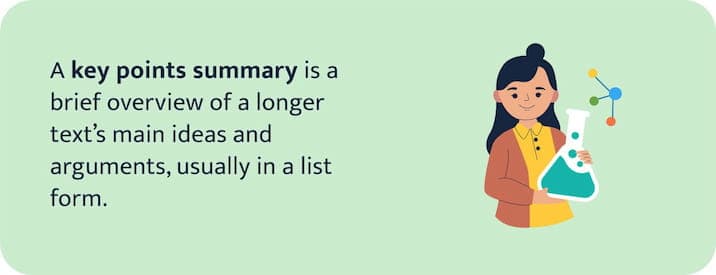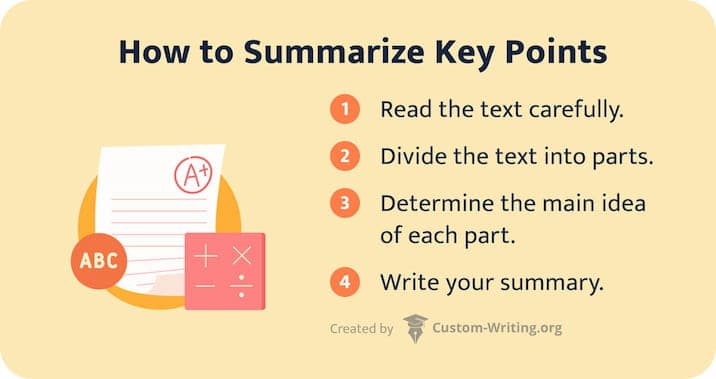Summarize Key Points: Generator for
Students
Isn’t it great when you can browse through the text’s essential ideas without having to read the entire thing?
Sadly, not everyone has the time or skills to write good summaries. But worry not! We present to you our free “summarize key points” generator. It’s a groundbreaking AI tool that will save you time and energy. With its help, you’ll always have quick and accurate summaries for whatever project you’re working on.
🎉 Why Choose Our “Summarize Key Points” Generator?
Our key ideas summarizer is one of the best tools you can find online. Its most noteworthy advantages include the following:
| 💸 Free of charge | It’s 100% free and unlimited. |
|---|---|
| 👍 Easy to use | You’ll enjoy our app’s interface. |
| 🚀 Advanced AI | It uses cutting-edge AI. |
| ⏳ Time-saving | Save energy and avoid academic stress. |
| 🌐 Universal | Summarize any text instantly. |
🤖 How Our Tool Works
Create a list of main ideas in 3 easy steps:
- Paste your text into the field. It can be up to 1000 words long.
- Specify how many core ideas you need.
- Press "Generate now."
And that’s it—you’ll obtain the results just like that!
💡 What Is a Key Points Summary?
A summary of essential points is a condensed variant of a longer text. It presents the author’s ideas in a list format in the same order as the source.

Typically, the length of the original text determines how long your synopsis will be. Short texts can be recapped in one paragraph, but lengthier articles may need more extended summaries to cover all the pivotal points.
Here’s what to include in your summary:
- The author’s name and the title of the original.
- The text’s major points.
- List of the arguments that back up the text's central idea.
And here’s what to exclude from your summary:
- Direct quotes from the original text.
- Small and unnecessary details.
- Things that weren’t present in the source text.
- Your thoughts regarding the author’s statements.
🔝 4 Advantages of Summarizing Key Points
Writing a great synopsis of central ideas can benefit you as a student. This activity's foremost advantages are:
- It improves your learning skills. While summarizing, you'll go through the original text multiple times. It’ll aid in your reading comprehension and allow you to identify the key ideas quickly.
- It helps prepare study notes. You can use your summary to memorize the material while preparing for tests.
- It boosts concentration. If you want to write a first-rate summary, it’s vital to focus on essential ideas and effectively distinguish them from insignificant ones. Trust us: this skill will prove useful many times.
- It structures your ideas in a meaningful way. Solid summarizing skills will make it easier to arrange your thoughts in a clear and neat order.
✍️ How to Summarize Key Points in 4 Easy Steps
Need help writing summaries of key ideas? Check this handy guide we’ve prepared for you!
1. Read the Text Carefully
You must fully comprehend the material if you want your summary to be precise. Even if it’s your own text, it’s better to read it more than once. Here's how to do it effectively:
- Quickly scan the text to get an overall idea of its contents and structure.
- Re-read the material thoroughly and underline all crucial information.
- Re-read it again and try to comprehend all challenging ideas you had trouble understanding.
Use the following tips to remember the pivotal details as you go through the text:
- Try reading the abstract first. It should already give you a synopsis of what to expect.
- Remember about headings and subheadings. Writing them down will help you structure your notes.
- Compare the opening passage with the conclusion. See how the text’s thesis is presented before and after the main body.
2. Divide Your Text into Parts
Break down the material you’re summarizing into manageable chunks to make it easier to read and apprehend.

A standard scientific publication will likely be split into sections with distinct headings, including an introduction, methodology, findings, and discussion. Yet, other texts may not be clearly divided into sections. Still, most articles and essays will be organized around several supporting ideas or topics.
3. Determine the Main Point of Each Section
The next stage is identifying the text’s primary ideas and how they link to each other. You can search for phrases or headings that highlight each section’s key points. Noting them can serve as a guide in the summary-writing process.
To make the task simple, answer the following questions:
- What’s the central thesis of the text that you’re reading?
- What are its main ideas?
- What are its arguments and claims?
4. Write Your Summary
Now, you’re prepared to start putting the text's main points together. Here are some things to remember while writing:
- Summaries of this type are generally presented as bullet points or numbered lists.
- When writing your summary as a paragraph, make each bullet point into a complete sentence.
- Consider using your notes as a skeleton of your summary. If you want to use them this way, it's best to polish and structure them appropriately.
- Try our key points summarizer! It will give you a perfect basis that you can use to build your summary.
✅ Excellent Summary of Main Points: Checklist
Now you know how to create a summary. But what makes it truly good? Let's see!
A strong summary is:
- Comprehensive. It should cover all key ideas from the original text. If the summary lacks essential elements, it becomes incomplete.
- Concise. If a summary constantly repeats itself or has unnecessary details, it loses its primary objective.
- Coherent. A strong summary is an organized list of points. It shouldn’t include direct quotes and random ideas.
- Independent. You don’t have to write the text exactly as the author did. Instead, stay true to your style. Use your own words, but avoid adding any personal remarks.
If your summary has all these properties, accept our congratulations—it’s perfect!
We hope that you enjoy using our awesome generator. Check it out right now and become a pro at summarizing key ideas!
We also recommend you check out our attention grabber generator and all-in-one citation machine.
❓ Summarize Key Points: Generator FAQ
- First, you’ll need to carefully and attentively read through the text that you want to summarize.
- Pay attention to all key ideas and critical points in the text.
- Take notes while reading.
- Finally, put your notes together and create a summary.
Custom-Writing’s free tool is one of the best key point summary generators online. Not only does it have the most advanced AI, but it's also 100% free of charge. Our summarizer can work with any text, whether it's an academic research paper, a novel chapter, or an essay.
A strong summary must be comprehensive, concise, and fully independent from its source. It means you must cover every central point mentioned in the original text while avoiding unnecessary details. It's also critical that the summary has no direct quotes or personal remarks.
- Read the original text.
- Highlight the key points and ideas.
- Divide the text into separate paragraphs.
- Take notes.
- Describe the central concept of the original text.
- Back up your statements with supporting evidence.
- End your summary with a thesis.
Updated:
🔎 References
- Guide: Helping Students Summarize and Respond to Texts: Colorado State University
- How To Write a Summary in 8 Steps (With Examples): Indeed
- Tips on Summarizing: UCLA Library Research Guides
- Guidelines for Writing a Summary: Hunter College
- Summarizing – Academic Integrity at MIT: Massachusetts Institute of Technology